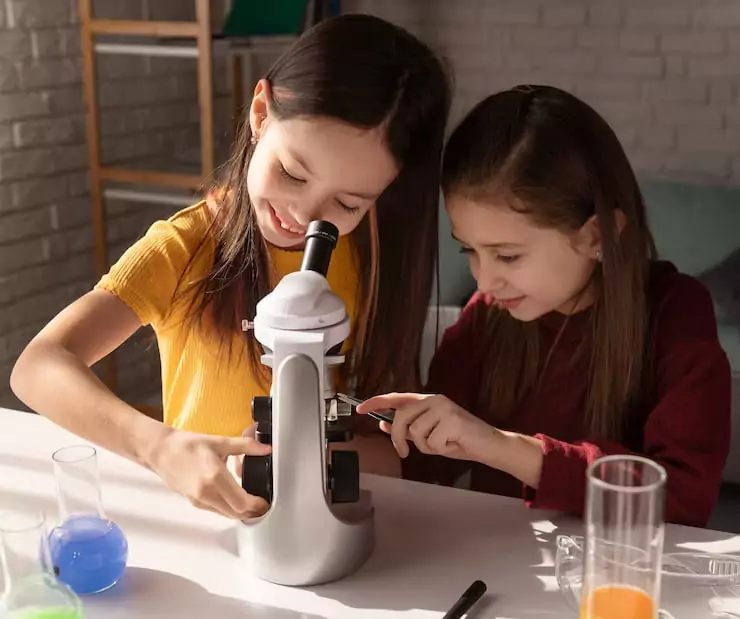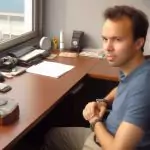
In the relentless pursuit of progress in Science, Technology, Engineering, and Mathematics (STEM) education, innovative approaches are not only welcome but urgently needed. Alex Dubin, an Endless Frontier Fellow at the Lincoln Network, advocates for a novel model inspired by the groundbreaking work of SpaceX’s experimental schools – Ad Astra, Astra Nova, and Synthesis.

✅ AI Essay Writer ✅ AI Detector ✅ Plagchecker ✅ Paraphraser
✅ Summarizer ✅ Citation Generator
Key Takeaways:
- Alex Dubin suggests SpaceX’s experimental schools could change the way we approach STEM education, focusing more on critical thinking and problem-solving.
- Astra Nova and Synthesis are building on Elon Musk’s Ad Astra school’s success, attracting venture capitalists with their innovative teaching methods.
- Dubin believes NASA could improve its STEM programs by adopting the techniques used by Astra Nova and Synthesis.
- The teaching methods used by Astra Nova and Synthesis could have a broader impact, influencing traditional schools and other STEM-focused organizations.
These initiatives, he argues, could potentially revolutionize how we educate our youth, equipping them with critical thinking skills, a strong ethical foundation, and a passion for problem-solving in addition to a solid grounding in scientific and technological principles. So, as the United States continues to strive for advancements in space exploration and STEM fields, the question arises: Can this pioneering model, which has already proven successful in nurturing the minds at SpaceX, be the key to effectively fostering the next generation of scientists, explorers, and innovators, thereby securing the nation’s leadership in these critical domains?
Learning from SpaceX’s Experimental Schools
Last year, the US moved closer to a return to the moon with NASA’s Artemis 1 mission and SpaceX’s Starship launch vehicle test. However, an equally crucial competition is unfolding on Earth: the development of science, technology, engineering, and math (STEM) education. Dubin’s article points to two exciting educational initiatives, Astra Nova and Synthesis, both successors of Elon Musk’s Ad Astra experimental school.
Ad Astra, a school that was primarily attended by children of SpaceX employees, held a strong emphasis on science and technology. Furthermore, it prioritized critical thinking skills, problem-solving, and ethics. This was all in a bid to inspire a passion for learning among its students. As Dubin notes, Musk’s only instruction to the school’s founders was a simple yet profound directive: “make it great.”
Astra Nova and Synthesis: The Next Frontier
Astra Nova and Synthesis, though not affiliated with Musk, have taken this foundation to new heights. Astra Nova offers an online, full-time curriculum with flexible courses and a focus on conundrums, or complex problems, to engage students to learn STEM disciplines. Meanwhile, Synthesis provides supplemental game-based education for students in traditional schools, aiming to make learning both engaging and rewarding. Chrisman Frank, now Synthesis’s CEO, described the program as tying together the student educational experience: “You have your other subjects, but Synthesis is like ‘now you’re making all this stuff work together.”

Both programs have piqued the interest of venture capitalists, raising significant funds and drawing praise for their innovative models of teaching.
NASA’s Role in STEM Education
Currently, NASA’s existing STEM programs, such as the Office of STEM Engagement (OSTEM), predominantly adhere to a more traditional approach. Unfortunately, this has led to certain problems. For instance, issues include duplication of efforts and a conspicuous lack of clear direction.
However, Alex Dubin proposes a solution. Dubin, an Endless Frontier Fellow at the Lincoln Network, highlights a potential remedy. He points to the innovative models of Astra Nova and Synthesis. These experimental schools, inspired by SpaceX, have proven successful.
Dubin suggests that NASA could benefit from their approach. His recommendation involves either supporting these innovative models or starting a similar initiative. But, it would require a more ambitious budget.
Innovative Approaches to STEM Education
Firstly, we’ll dive into a detailed comparison of Ad Astra, Astra Nova, and Synthesis, each of these being innovative educational initiatives with a focus on STEM education. The comparison initially highlights their unique origins, followed by an exploration of their distinctive learning formats. Subsequently, we delve into their educational focus and structures, shedding light on the number of students each initiative serves. Next, we examine the tuition and assistance provided by each program, before considering their ultimate aims. Furthermore, we evaluate the investors and funding each initiative has attracted, and finally, we speculate on their future potential in the field of STEM education.
| Criteria | Ad Astra | Astra Nova | Synthesis |
| Origin | Founded by Elon Musk, primarily for children of SpaceX employees | A successor to Ad Astra, unaffiliated with Musk | Developed from a specific class at Ad Astra, unaffiliated with Musk |
| Learning Format | In-person learning housed within SpaceX facilities | Entirely online, offering full-time and part-time options | Entirely online, offering part-time supplemental education |
| Educational Focus | Science and technology, critical thinking skills, problem solving, and ethics | Flexible curriculum with emphasis on broad STEM topics, critical thinking via Conundrums | Game-based curriculum prioritizing collaboration, observation, and problem-solving |
| Structure | Abandoned traditional grade levels and topics for a more flexible learning approach | Lacks rigid traditional courses and structures, allowing for an agile, iterative approach | Not separated by age, providing a supplemental addition to traditional education |
| Number of Students | Limited (Closed in 2020) | Approximately 50 full-time and 125 part-time students, open to the public via an application process | Plans to scale up to a much larger student body, beyond those of SpaceX employees |
| Tuition and Assistance | Not specified | Full-time tuition is $33,500, with 33% of full-time and 6% of part-time families receiving tuition assistance | Not specified, but with an admissions process in place, the founders hope to scale up the concept to open doors to all |
| Ultimate Aim | To inspire an eagerness to learn, with a directive from Musk to “make it great” | To be agile and iterative, helping students explore a broad list of STEM topics critical to future U.S. leadership in science and technology | To make learning both engaging and rewarding, with an aim to tie together the overall student educational experience |
| Investors and Funding | Not specified | Not specified | Raised $12 million in a round led by Balaji Srinivasan and Amjad Masad, described as “the future of education” by O’Shaughnessy Ventures |
| Future Potential | Continued influence through Astra Nova and Synthesis | Potential for collaboration with NASA, lessons could be used in traditional schools or by individuals at home | Content, games, and lessons could be integrated into traditional education, as well as used at home |
10 Must-Read Books for Aspiring STEM Enthusiasts
For those embarking on a journey in the Science, Technology, Engineering, and Mathematics (STEM) fields, immersing oneself in literature that inspires, educates, and fosters curiosity is a worthwhile endeavor. Here is a collection of ten must-read books that offer invaluable insights into the fascinating world of STEM.
- “The Man Who Knew Infinity: A Life of the Genius Ramanujan” by Robert Kanigel: This biography takes readers into the mind of Srinivasa Ramanujan, a self-taught mathematician from India. His story is a testament to the power of perseverance and innate talent.
- “The Immortal Life of Henrietta Lacks” by Rebecca Skloot: A compelling narrative about the collision of ethics, race, and medicine, it explores the story of Henrietta Lacks, whose cells—taken without her knowledge—have revolutionized biomedical research.
- “A Brief History of Time” by Stephen Hawking: In this classic, Hawking makes cosmology accessible to the general audience, discussing theories about the universe’s origin and fate, the nature of black holes, and time’s intricacies.
- “Hidden Figures” by Margot Lee Shetterly: This book uncovers the often-overlooked contributions of Black female mathematicians at NASA during the Space Race. It is a celebration of resilience, brilliance, and the human spirit.
- “The Gene: An Intimate History” by Siddhartha Mukherjee: Mukherjee eloquently details the gene’s history, from Mendel’s experiments to CRISPR, weaving in his family’s history of mental illness. It is a crucial book for anyone interested in genetics and bioengineering.
- “The Innovators” by Walter Isaacson: The book provides a comprehensive overview of the digital revolution and the people who shaped it, shedding light on their collaborative approach to innovation.
- “The Emperor of All Maladies: A Biography of Cancer” by Siddhartha Mukherjee: This Pulitzer-winning book delves into cancer’s history, offering insights into this formidable disease and humanity’s ongoing battle against it.
- “Gödel, Escher, Bach: An Eternal Golden Braid” by Douglas Hofstadter: A unique blend of mathematics, art, and music, this book explores concepts like self-reference and formal rules, stimulating critical thinking.
- “Lab Girl” by Hope Jahren: This memoir presents a personal and passionate perspective on botany and scientific research, told through Jahren’s experiences in the field.
- “Code: The Hidden Language of Computer Hardware and Software” by Charles Petzold: For those interested in computer science, Petzold demystifies the inner workings of computers, making this complex field accessible to all.

These books illuminate various STEM aspects, inspiring a sense of wonder, encouraging deep understanding, and fostering a lifelong love for these fields. Through these pages, aspiring STEM enthusiasts can begin to grasp the universe’s complexities and the human ingenuity propelling us forward.
Looking Ahead: The Potential Impact of Experimental Schools
Dubin argues that these new STEM programs could have a broader impact than just their enrolled students. Their content could be used in traditional schools or even by individuals at home. The programs could also serve as a model for other agencies and organizations looking to bolster their own STEM efforts.
Recounting his visit to Ad Astra, Synthesis CEO Chrisman Frank observed that “the spark of curiosity and agency so often dulled by our industrial education system still burned bright with these kids… it was clear the kids relished the challenge.”
In summary, Alex Dubin’s article presents an exciting exploration of how experimental schools like Astra Nova and Synthesis could revolutionize STEM education in the United States. As the world races to produce more STEM graduates, this fresh approach could be just what the nation needs to keep pace.
Related stories:
US Seeks Public Input on AI Regulation as ChatGPT Gains Popularity
The Post-Pandemic Puzzle: High School Diplomas Rise Amid Declining Test Scores and Attendance
From Classroom to Screen: Reshaping Nursing Education in a Pandemic World
Follow us on Reddit for more insights and updates.





Comments (0)
Welcome to A*Help comments!
We’re all about debate and discussion at A*Help.
We value the diverse opinions of users, so you may find points of view that you don’t agree with. And that’s cool. However, there are certain things we’re not OK with: attempts to manipulate our data in any way, for example, or the posting of discriminative, offensive, hateful, or disparaging material.